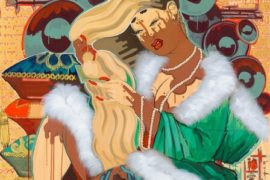SOURCE: NATIONAL GALLERY OF ART
STANDARDS OF BEAUTY
Standards of Beauty
What’s beautiful to you? What does this work of art make you think about women in your own community and culture? Who might you want to be in dialogue with to better understand this painting?
Rozeal uses the title of this work, a play on Aphrodite, ancient Greek goddess of love and beauty, to present a cross-cultural rebellion on beauty ideals that traverses the Eastern and Western Hemispheres.
Rozeal spent time in Japan through a fellowship program and became interested in the ganguro style, whereby young Japanese women counter traditional beauty norms by wearing skin-darkening makeup, dying their long hair blonde, and applying long nail tips. As a DJ and performance artist, Rozeal underscores ganguro’s references to African American hip-hop culture—seen in the words “back and forth” repeated in the background, a quotation from the song “Whip My Hair” by Willow Smith, while music discs frame the figure. The stylized appearance and pose of the figure recall Japanese 19th-century ukiyo-e prints, which traditionally depict a fantasy world of nightlife and geisha.
Explore more about afro.died.T
Racism and Immigration
What does barbed wire make you think of? How does it function here as a symbol?
Rupert García is a Mexican American artist from California whose work addresses civil rights, racism, and specific injustices against Latin American communities. He created this poster—“Cease Deportation!” in English—in the early 1970s to protest deportations of undocumented Mexican immigrants. Legislative efforts to criminalize immigrants followed on the heels of the bracero program, which brought millions of Mexican guest workers to the United States between 1946 and 1964.
Many Chicano artists—those of Mexican descent—use barbed wire in their works.
Explore more about ¡Cesen Deportación!
Gender and Identity
Are there any activities or practices in your own life that are viewed as belonging to a specific gender? How do you feel about this perception?
Iturbide is among the foremost figures in Mexican photography, known for her work documenting Indigenous cultures around the world. In 1978 the Instituto Nacional Indigenista hired her to photograph Mexico’s Indigenous populations. As part of that work, she traveled to Juchitán, whose inhabitants are of Zapotec heritage, with a matriarchal society. This photograph is from that project, collectively published as Juchitán de las Mujeres (1989).
Iturbide’s practice involves immersing herself into the communities that she photographs. While shopping for groceries one day, she was approached by Magnolia, who wanted her picture taken. Magnolia was part of a community of muxes, individuals assigned male at birth but who identify as other genders. In some Indigenous cultures, muxes are considered a third gender and people with special powers. Magnolia holds a mirror up to her profile, doubling her image and suggesting the multiple ways that identity may be presented.
Explore more about Magnolia
Class and Citizenship
What does Siqueiros tell you about himself in this self-portrait? What indications do you see in this portrait that Siqueiros is serving the proletariat rather than the bourgeoisie?
Born in 1896 in Chihuahua, Mexico, to a bourgeois family, Siqueiros went to Mexico City as a teenager to study art and architecture. The year was 1910, the beginning of the Mexican Revolution. He became immediately involved in student strikes to fight for the rights of Mexican workers and the poor. At age 18, he joined the Mexican Revolutionary Army, and later, the Communist Party. Jailed and exiled from Mexico several times for his radical views and his harsh criticism of the Mexican government, he continued to fit for the rights he believed in for the rest of his life.
For Siqueiros, the star was a symbol of socialism. He includes it to reinforce his central belief: “The artist . . . must make up his mind to serve either the bourgeoisie or the proletariat. I believe that painting and sculpture should serve the proletariat in their revolutionary class struggle.”
Explore more about Self-Portrait
Civil Rights and Taking Action
What slogans or images have inspired you to act? How is kneeling used as a form of protest today?
In 1962 photographer Danny Lyon captured three young African Americans protesting through prayer in front of a “whites-only” swimming pool and recreational facility in Cairo, Illinois. Their demonstration was part of a larger effort to integrate businesses and other spaces in the town. Lyon was involved in the movement and developed strong relationships with members of the Student Nonviolent Coordinating Committee (SNCC), a group of young people who were committed to full-time grassroots organization. Through his involvement, Lyon captured many aspects of SNCC’s efforts, from prayer demonstrations led by a young John Lewis (at left) to violence suffered by students at the hands of the National Guard. John Lewis continued his activism for many years and was elected to the US Congress in 1986, where he served as a representative for Georgia in the House of Representatives until his death in 2020.
SNCC used this 1962 photograph to develop its public image in support of expanded rights for African Americans. For example, it was used as part of a poster series; printed in bold below the demonstrators’ photograph were the words “come let us build a new world together.” What does “come let us build a new world together” mean to you?
Explore more about John Lewis and Colleagues, Prayer Demonstration at a Segregated Swimming Pool, Cairo, Illinois
Incarceration
Eddie chose how he would look for his photograph. Why do you think he chose to wrap himself in a flag?
Deborah Luster was one of a few photographers hired to document parishes in northeastern Louisiana in the late 1990s for a federal grant application. As she drove around, deciding what to document, she began to wonder, “Where are all these people?” She started to notice small prisons dotting the landscape. “Maybe they’re all in prison?”
Luster’s stop at one of the prisons led to One Big Self: Prisoners of Louisiana, a project in which she documented prisoners held in correctional facilities across Louisiana, including the infamous Angola penitentiary. This photograph has writing on the back, giving us some details about Eddie M. “Fat” CoCo, including his future plans: “Be success/Lawyer”
Explore more about Eddie M. “Fat” Coco Jr., Transylvania, Louisiana
Healthcare Access
Imagine being in the shoes of the two women and what their lives might be like. What questions does this work of art raise?
Incisive, searing, and tender social commentary inhabits the work of Ben Shahn, a Lithuanian-born Jewish immigrant to the United States whose work consistently investigates issues related to injustice. Shahn’s “social realist” Prenatal Clinic shows two pregnant women in an icy green waiting room sitting below a poster reading “Do I deserve prenatal care?”
Explore more about Prenatal Clinic
Internment and Discrimination
Why do you think this photograph might have been seen as subversive or critical of the government? What do you think this image symbolizes or represents?
After the Japanese bombing of Pearl Harbor in 1941, the US government imprisoned more than 100,000 Japanese Americans living on the West Coast in internment camps. More than half of these people were US citizens, and many of them were children.
Dorothea Lange was hired by the War Relocation Authority to document the incarceration process. She photographed a group of public school children reciting the Pledge of Allegiance to the American flag in 1942 in San Francisco, California, as the roundup efforts began. It’s likely some of these children were sent to internment camps. The federal government hoped to use Lange’s images to promote the internment program. Instead, this photograph was one of many Lange took that were impounded by the federal government for the duration of World War II.
Explore more about Children of the Weill public school shown in a flag pledge ceremony, San Francisco, California
Stereotypes and Appropriation
Where in your life do you see appropriation of Native American imagery? Consider other products, symbols, and visual media.
I See Red: Target is part of a series by artist Jaune Quick-to-See Smith (enrolled Salish, member of the Confederated Salish and Kootenai Nation, Montana). She began the series in 1992 upon the 500th anniversary of Christopher Columbus’s landing in the Americas. The work incorporates stereotypes, racist tropes, and imagery that relates to the appropriation of Native Americans. Said Quick-to-See Smith, “I reference Indians being the Target of the corporate world of mascots and corporate goods.”
Look closely at this work and you will see that it is a collage. Quick-to-See Smith adds images and headlines from magazines and newspapers, including the Char-Koosta News, the Flathead Reservation newspaper published where she grew up. The dartboard serves as a target, with darts placed around it like feathers in a headdress. A pennant at top left celebrates the Washington football team, winners of the 1992 Super Bowl over the Buffalo Bills. Quick-to-See Smith refers to the Bills’ mascot, the bison, at upper right; the appearance of a racial slur for Native Americans connects to the work’s title and its dominant color.
Explore more about I See Red: Target
Housing and Homelessness
What parts of the scene tell you that this group of people may have fallen on hard times?
While one man works, sawing wood at the center of the image, others sit on the ground around him, dozing or reading a newspaper perhaps. The time may be night, with illumination coming from streetlights beyond where the men are gathered. A poster with an alluring female figure is featured, perhaps advertising a burlesque show, and suggesting moral temptations to men not gainfully occupied. Although the setting is ambiguous, the man may be sawing wood to create a shanty or shelter of some sort, as the slanted panels just behind him suggest. During the Depression, people made homeless by the crisis often built such improvised structures. Groupings of such dwellings were dubbed “Hoovervilles” in critique of President Herbert Hoover (in office from 1929 to 1933), who was unable to enact programs to effectively assist people plunged into poverty by the Depression.
____________________________________________________________________________________________________________________________________________________________________________________________________________________________________
A Message from Wa-Wo & WaWoWave:
BREAKING NEWS…!!! Wa-Wo ONLINE ART-GALLERY is now open in:
(click here) zazzle.com/store/wawowave
Many other online stores to be open soon in Wa-Wo SHOPIFY, Wa-Wo AMAZON & Wa-Wo ETSY… They will be in a constant renewal process, updating it’s collections with new items and designs…
Do you want to give a loved one a unique gift that expresses what you really feel for them? Choose from hundreds of items and imprint on them Wa-Wo Art beautiful designs…
ART- 4 – SALE in : zazzle.com/store/wawowave
Enjoy a piece of Wa-Wo Art from its Collection Items on your walls, on your kitchen, on your bedding, even on your bathroom…
Drink from Wa-Wo Art MUGS imprinted with Wa-Wo Collection Items…
Wear your Wa-Wo Art Collection Items, on a SHIRT, or HAT, or JACKET, or even in your LEGGINGS, PAJAMAS, BIKINIS, UNDERWEAR & so much more…
Walk with SHOES or FLIP-FLOPS designed with Wa-Wo Art…
CHANGE YOUR LIFESTYLE… MAKE A STATEMENT with Wa-Wo Art Collection Items…!!!
Buy all your essentials with unique artistic designs at: zazzle.com/store/wawowave














